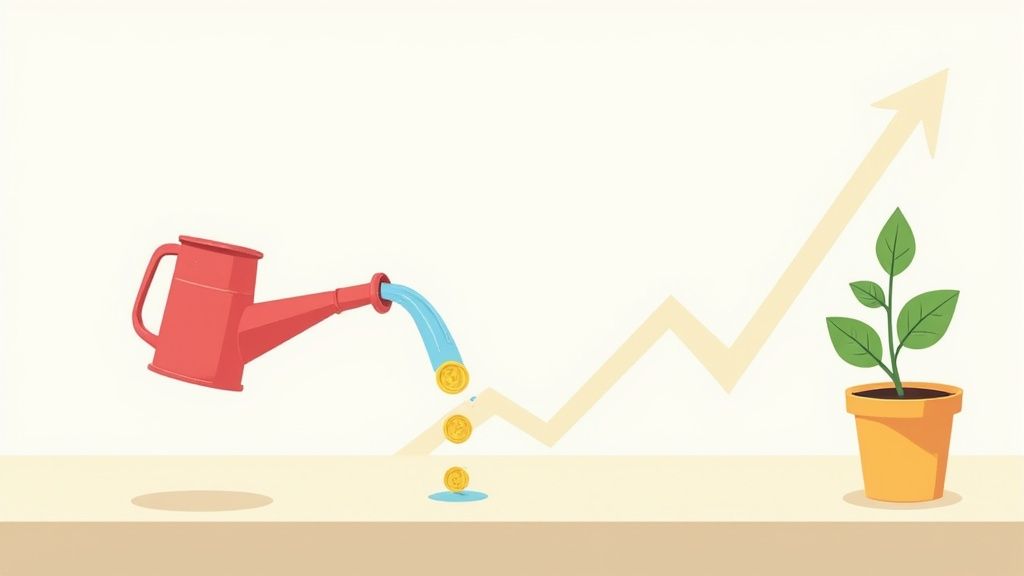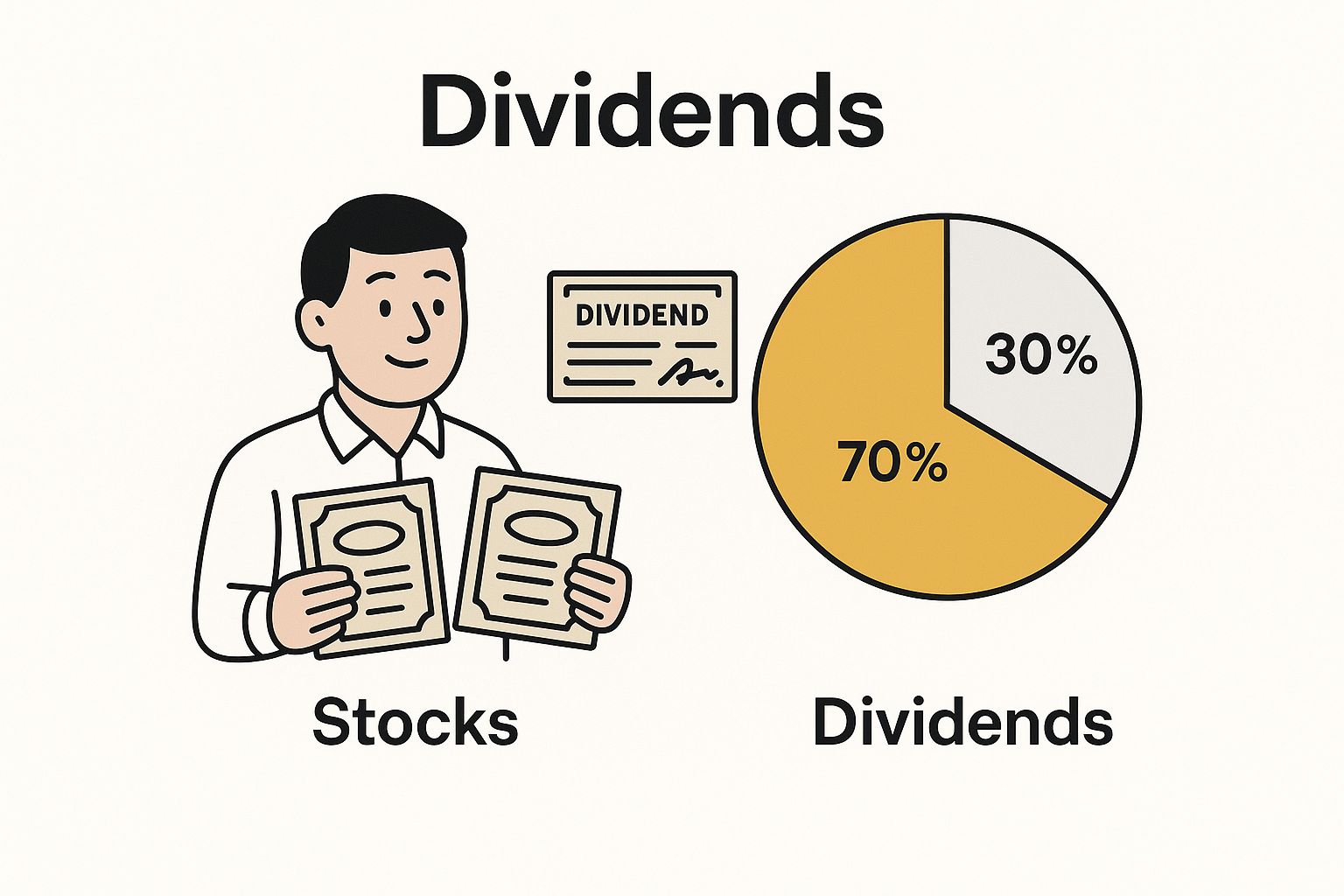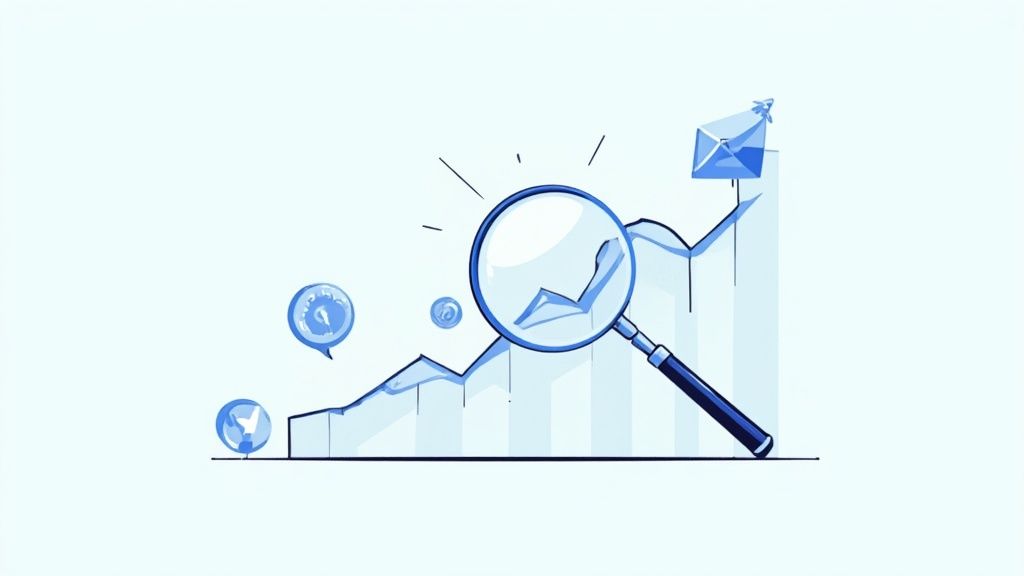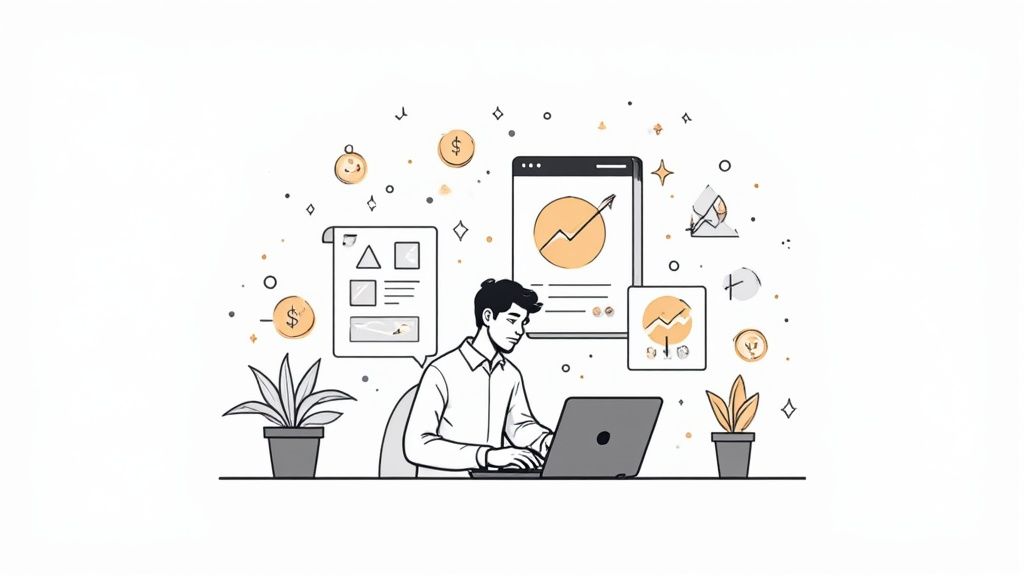A dividend investing strategy is all about buying stocks in companies that share their profits with you, the shareholder. These regular payouts can create a steady stream of passive income.
It's a simple way to build wealth: you collect regular cash payments from your stocks and then use that money to buy even more shares. Before you know it, your investments start working for you, creating a self-sustaining cycle of growth.
Why Dividends Are Your Secret Weapon for Wealth
Imagine getting paid just for owning a small piece of a company you believe in. That's the simple, powerful idea behind dividend investing. It's not some complex scheme reserved for Wall Street pros; it’s a practical way for anyone, even someone just starting at 16 or 18, to build real, long-term wealth.
Think of it like this: you own a tiny apple orchard. Each tree (a stock) not only grows more valuable over time, but it also produces apples (dividends) every season. You can either enjoy the apples now or plant their seeds to grow more trees. A smart dividend strategy is all about planting those seeds.
The Magic of Compounding
When you reinvest those dividend payments, you kick off a powerful snowball effect. This is the magic of compounding, which Albert Einstein supposedly called the "eighth wonder of the world." Your initial investment pays you, and then those payments start earning money of their own.
Warren Buffett is a master of this. His company, Berkshire Hathaway, pulls in billions in dividends each year from stocks like Coca-Cola and Apple. He then puts that cash right back to work, buying more assets. It's a virtuous cycle of growth that can turn a modest starting sum into a fortune over time.
"Compound interest is the eighth wonder of the world. He who understands it, earns it… he who doesn't… pays it." – Often attributed to Albert Einstein
This infographic breaks down how you, as an investor, can benefit from holding stocks and pocketing those sweet dividend payments.
As you can see, the core idea is simple: owning shares can generate a direct cash return, fueling your portfolio's growth.
More Than Just Pocket Money
Dividends aren't just a small bonus; they are a massive part of what makes the stock market so powerful. In fact, between 1987 and 2023, reinvested dividends made up about 55% of the total return from U.S. stocks. The other 45% came from stock prices going up.
Let that sink in. If you had ignored dividends, you would have missed out on more than half of the market's historical gains. You can find more insights about the power of dividends on the J.P. Morgan Asset Management site.
By focusing on companies that share their profits, you're not just a speculator hoping a stock price goes up – you're a part-owner in a business. This mindset shift encourages patience, helps you ride out the inevitable market swings, and turns the dream of passive income into a tangible reality, even if you're just starting small.
How to Find Great Dividend Stocks
Alright, this is where the fun begins – the treasure hunt for solid dividend-paying companies. But before you dive in, know this: not all dividend stocks are created equal. A sky-high dividend yield can look tempting, but it's often a siren song luring you toward a company in deep trouble.
Your real goal is to find healthy, resilient businesses that are built to last. You're looking for companies that don't just pay a dividend now but have every intention of paying – and raising – it for years to come.
Look for Dividend Champions
Let’s start with the A-listers of the dividend world: the "Dividend Aristocrats." These are S&P 500 companies that have managed to increase their dividend payouts for at least 25 consecutive years. We're talking about giants like Coca-Cola and Johnson & Johnson.
Think about what that track record really means. It signals a company with incredible financial stability and a management team that is deeply committed to rewarding its shareholders, rain or shine. Hunting for companies with a long history of raising their dividends is one of the smartest first moves you can make.
Check the Payout Ratio
So, how can you tell if a dividend is actually sustainable? The key metric here is the payout ratio. It’s a simple calculation that tells you exactly what percentage of a company's profits are being returned to shareholders as dividends.
For instance, if a company earns $100 million and pays out $40 million in dividends, its payout ratio is a comfortable 40%. I generally look for a sweet spot between 30% and 60%. This shows the company can easily afford its dividend while still keeping plenty of cash to reinvest in growth.
A payout ratio creeping over 80% is a major red flag for me. It suggests the company is stretching itself thin, leaving little room for error if profits take a hit. One bad quarter could lead to a dividend cut.
Historically, global payout ratios have hovered around 56%, but in recent years, they’ve been closer to 36%. This is actually great news for investors, as it suggests many strong companies have plenty of firepower to keep growing their dividends. If you're curious about the bigger picture, Hartford Funds has a great piece on why dividend growth is expected to accelerate.
Spotting Strong vs. Risky Dividend Stocks
It can be tricky to tell the difference between a sustainable dividend champion and a high-yield trap at first glance. This quick comparison chart breaks down what I look for versus what makes me cautious.
| Characteristic | What a Healthy Stock Looks Like | Red Flag to Watch Out For |
|---|---|---|
| Dividend History | A long, consistent record of paying and increasing dividends. | Erratic payments, a recent cut, or a yield that seems too good to be true. |
| Payout Ratio | A sustainable ratio, typically under 60%. | An extremely high ratio (80%+) or a negative one (paying with debt). |
| Business Fundamentals | Growing revenue and profits, strong brand, dominant market position. | Declining sales, shrinking profits, and losing ground to competitors. |
| Balance Sheet | Low to moderate debt levels, giving it financial flexibility. | A huge debt load that could jeopardize dividend payments during tough times. |
Think of this table as your field guide. Keep these points in mind, and you'll get much better at spotting the reliable workhorses from the ticking time bombs.
Build a Simple Checklist
When you're sifting through potential investments, it really helps to have a simple, repeatable checklist. This keeps you grounded and focused on the qualities that truly build long-term wealth.
Here’s a basic framework I use to vet potential dividend stocks:
- A Strong "Moat": Does the company have a durable competitive advantage? This could be a powerful brand like Nike's, a patent portfolio, or a sticky ecosystem like Apple's.
- Consistent Profit Growth: I want to see a clear history of steady earnings growth over the last five, or even ten, years. Bumpy profits can lead to bumpy dividends.
- Low Debt: A company with a clean balance sheet is more resilient. Too much debt can sink a business during a recession, taking its dividend down with it.
- A History of Raises: We've already covered this, but it's worth repeating. A track record of dividend increases is a fantastic sign of a shareholder-friendly culture.
By sticking to a simple process like this, you'll learn to look past the tempting-but-dangerous high yields and start building a portfolio of true dividend champions.
Putting Your Dividend Strategy Into Action
Alright, theory is great, but now it's time to roll up our sleeves and actually build this thing. This is where your plan meets the real world. The first step is purely practical: you need a brokerage account. If you’ve ever signed up for Netflix, you've got this – it's a straightforward online process that takes just a few minutes.
With your account funded and ready, you’ll face your first major fork in the road. Will you be a stock picker, or will you opt for the simplicity of a dividend ETF? There’s no single "right" answer here, only what's right for you.
Picking Individual Stocks vs. Buying ETFs
Hand-selecting your own stocks can be incredibly satisfying. You get to be a business analyst, hunting for those hidden gems and future dividend champions. It gives you ultimate control to build a portfolio that’s a perfect reflection of your own research and convictions.
The catch? It’s more work. A lot more. You're responsible for the deep-dive research, ongoing monitoring, and maintaining the discipline to stick with your plan. It can also be tough to achieve proper diversification right out of the gate when you're buying one company at a time. As you start out, good investment diversification strategies are absolutely vital for managing risk.
On the flip side, you have dividend ETFs (Exchange-Traded Funds). Think of an ETF as a curated basket of dividend stocks. In one single transaction, you can own a small slice of dozens or even hundreds of companies. This is a game-changer for beginners because it provides instant diversification.
Here’s a simple way to think about it:
- Choose Individual Stocks if: You genuinely enjoy the research process, crave total control over your holdings, and have the time to commit to it.
- Choose a Dividend ETF if: You prefer a simpler, more hands-off approach that gives you broad market exposure and diversification from day one.
Of course, you don’t have to choose just one. A popular strategy is to build a core portfolio with a solid dividend ETF and then add a few individual companies you're really excited about.
Let Your Dividends Do the Work for You
Once you've made your first purchase, there's a simple setting that can dramatically accelerate your growth over time. It’s called a Dividend Reinvestment Plan, or DRIP.
Virtually every brokerage offers this, and it’s usually just a checkbox in your account settings.
When a DRIP is turned on, any dividend you receive is automatically used to buy more shares of that same stock or ETF. It doesn't matter if it's only enough for a fraction of a share – that cash gets put right back to work.
This is the magic of compounding in its purest form. Your investments pay you, and that payment immediately starts earning its own money. It's a completely passive way to make your portfolio grow faster.
Imagine a small snowball rolling down a hill. Every time your dividends are reinvested, the snowball gets a little bigger, allowing it to pick up more snow on its next revolution. Turning on your DRIP is one of the most powerful, yet simple, moves you can make to set your dividend strategy up for long-term success.
How to Manage Your Dividend Investments
https://www.youtube.com/embed/eJmt9sqDFNc
Alright, you've built your portfolio. That's the first big step, but it's really just the beginning of the journey. The real trick to winning with dividend investing is learning how to manage your portfolio for the long haul – without it turning into a stressful, second job.
Think of yourself as a business owner, not a day trader. You're in it for the long game.
Investing is a marathon, not a sprint. The market will have its good days and its bad days; that’s just part of the deal. Patience is your superpower here. Legendary coach John Wooden once said, "The most important key to achieving great success is to decide upon your goal and launch, get started, take action, move." Your goal is steady, long-term growth, so don't let the small dips spook you.
Diversification Is Your Best Friend
You’ve heard it a million times: “Don’t put all your eggs in one basket.” It might sound cliché, but when it comes to investing, this is the golden rule of diversification. Spreading your money across different sectors is absolutely essential for managing risk.
Imagine you only owned tech stocks. If the tech industry hits a rough patch, your entire portfolio takes a nosedive. But, if you also own shares in consumer goods, healthcare, and utilities, the stability in those areas can cushion the blow. It’s all about balance.
A well-rounded portfolio might include a mix of:
- Tech Sector: High-growth potential, but can be volatile.
- Consumer Staples: Rock-solid companies selling things we always need, like food and soap (think Procter & Gamble).
- Utilities: The businesses that keep the lights on and the water running – often dividend powerhouses.
- Healthcare: An industry that’s always in demand, no matter what the economy is doing.
This simple strategy of spreading things out is what lets you sleep at night, even when the market gets a little turbulent. It’s the buffer that protects your hard-earned money.
Knowing When to Hold and When to Fold
So, when do you actually hit the "sell" button? It's almost never because of a short-term price drop. The real red flag is when a company suddenly cuts or completely gets rid of its dividend. That’s often a clear signal the business is in deep financial trouble.
But it’s equally important to know when to just hang on. Investing legends like Warren Buffett built their empires by holding onto great companies through thick and thin, collecting those dividend checks along the way. He doesn't dump a solid business just because its stock is having a bad month.
Owning a dividend stock is like a long-term partnership. You only end that partnership when the company's story fundamentally changes for the worse – not because of temporary market noise.
The Simple Annual Health Check
Once a year, take a few minutes to give your portfolio a quick health check. It doesn't have to be complicated. Just ask yourself a few simple questions:
- Is my portfolio still in line with my long-term goals?
- Did any of my companies slash their dividends?
- Do I need to rebalance a bit by adding to a sector I'm light on?
This quick review is all it takes to keep your strategy on the right path. The proof is in the pudding. One analysis of U.S. stocks from 1928 to 2017 found that the top 20% of dividend-paying companies could have turned $1 million into more than $21 million. Meanwhile, the non-dividend payers only grew to about $1.7 million. You can dig into the historical data on these returns to see just how powerful this is over time.
And finally, don't get too bogged down with taxes right away. In the U.S., most dividends from stocks you hold for at least a couple of months are considered "qualified." This means they're taxed at a much lower rate than your regular income – a nice little bonus for being a patient investor.
Common Dividend Investing Mistakes to Avoid
We’ve all heard that learning from your mistakes is smart, but learning from other people's mistakes is even smarter – and a lot cheaper. When it comes to dividend investing, sidestepping a few common traps can be the difference between a growing income stream and a portfolio full of regrets.
Let's walk through the biggest blunders I see investors make, so you can avoid them from day one.
Don't Fall for the "Yield Trap"
The most tempting mistake, by far, is chasing a sky-high yield. You see a stock with an 8% or 10% dividend and think you’ve hit the jackpot. It feels like a no-brainer, right?
Slow down. An unusually high yield is more often a warning sign than an opportunity. It usually means the stock price has been hammered because investors are fleeing. That high yield might not last long – it's often a precursor to a dividend cut.
Think of it this way: if a dividend yield looks too good to be true, it almost always is. That flashy 10% yield could easily turn into 0% overnight, leaving you with a shrinking stock on top of a lost income stream.
Remember, You're Buying a Business, Not Just a Dividend
Another pitfall is getting so fixated on the dividend that you completely ignore the underlying business. The best dividend stocks come from companies that are actually growing. You want the whole package: a reliable dividend payment and a stock price that appreciates over time.
Here's a simple comparison:
- Company A: Pays a stagnant 5% dividend, but its earnings are flat and the stock price has been bouncing around the same level for years.
- Company B: Pays a more modest 2% dividend, but it’s consistently growing its profits by 10% a year, and the stock price is climbing steadily.
Which one do you think builds more wealth? It’s Company B, hands down. Your total return – the dividend plus the stock's appreciation – is what truly matters.
Keep Your Emotions in Check
This is the hard one, the one that trips up even seasoned pros. The market is an emotional rollercoaster, and our gut reactions are often dead wrong. When things get scary and stocks are tanking, the urge to sell everything is powerful. When the market is euphoric, the fear of missing out can push you to buy at the absolute worst time.
Warren Buffett's mentor, the legendary Benjamin Graham, said it best.
"The investor's chief problem – and even his worst enemy – is likely to be himself." – Benjamin Graham
He knew that our own psychology is the biggest hurdle. Having a solid, pre-defined dividend strategy is your best defense. When you’re focused on the simple goal of collecting your next dividend check from a great company, it’s much easier to tune out the daily market chaos and stay the course.
Stick to your plan. Focus on quality. Be patient. That's how you invest with a clear head and avoid making costly decisions driven by fear or greed.
Got Questions About Dividend Investing? Let's Get Them Answered
Alright, let's tackle some of the common questions that always come up when you're just getting your feet wet with dividend investing. Think of this as your quick-start FAQ to clear up any confusion and get you moving forward.
How Much Money Do I Really Need to Start?
Honestly, you can get started with whatever you've got. The old myth that you need a huge pile of cash to be an investor is just that – a myth. Thanks to fractional shares, most online brokers will let you buy a tiny slice of a massive company for as little as $1.
What matters most isn't the dollar amount you begin with, but the consistency. It's about building the habit. Seriously, investing just $20 a week can snowball into something substantial over the years, especially if you have a long time horizon for compounding to work its magic.
Are Dividends a Sure Thing?
This is a fantastic and super important question. The short answer is no, dividends are not guaranteed. A company's board of directors can choose to raise, lower, or completely cut their dividend payments whenever they see fit.
This is precisely why we put so much emphasis on picking financially solid companies. A business with a long track record of not just paying, but consistently increasing its dividend is sending a powerful signal. It tells you they’re stable, confident in their future earnings, and committed to rewarding their shareholders.
Look at a company like Procter & Gamble, the giant behind brands like Tide and Gillette. They've paid a dividend for over 130 years and have bumped it up for more than 60 consecutive years. That's the kind of reliability you're looking for.
What's a DRIP and Should I Bother With It?
DRIP is short for a Dividend Reinvestment Plan. It’s a beautifully simple feature your broker offers that automatically takes the cash dividends you receive and uses them to buy more shares of that same stock – often in tiny, fractional amounts.
So, should you use one? If you're investing for long-term growth, the answer is an absolute, unequivocal yes. A DRIP is like setting your compounding machine on autopilot. Instead of a few bucks landing in your cash balance, that money is instantly put back to work, buying you more assets that will generate even more income. It’s a game-changer.
How Often Will I Actually Get Paid?
It really depends on the company, but the standard payout schedule for most U.S. stocks is quarterly. This means you can expect a check (or a direct deposit into your brokerage account) every three months, which creates a nice, predictable income flow.
That said, you'll see some other schedules out there:
- Semi-Annually: Paid out twice a year.
- Annually: Just one payment per year.
- Monthly: This is a favorite for income-focused investors. Some funds and Real Estate Investment Trusts (REITs) pay out every single month, which is fantastic for managing cash flow.
No matter how often the payments come, the core goal of your dividend investing strategy stays the same: build a growing stream of income you can rely on.
Ready to put this knowledge into practice? financeillustrated.com has free, easy-to-digest lessons and simulators that let you build your investing skills from scratch. Start your journey with confidence at https://financeillustrated.com.



